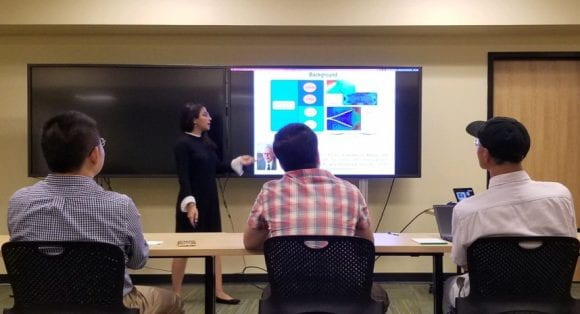Congratulations Prosenjit on his paper published in Acta Mechanica
Congratulations Prosenjit! His paper “Numerical Prediction of Orthotropic Elastic Properties of 3D Printed Materials using Micro-CT and Representative Volume Element” was accepted for publication in Acta Mechanica. Here is the abstract (the paper link):
Numerical Prediction of Orthotropic Elastic Properties of 3D Printed Materials using Micro-CT and Representative Volume Element
P. Biswas1, S. Guessasma2, J. Li1*
1. Department of Mechanical Engineering, University of Massachusetts, Dartmouth, MA 02747
2. INRA, UR1268 Biopolymères Interactions Assemblages, F-44300 Nantes, France
The mechanical property of 3D printed components often exhibits anisotropic behaviors and a strong dependence on printing orientations and process parameters. In this study, computational models based on microstructures of 3D printed ABS polymers are developed using micromechanics of representative volume element (RVE) to investigate the orthotropic elastic properties. Two finite element (FE) models, based on Micro-CT or CAD geometry, with different raster angles: 0°, 30°, 45°, and 60° (corresponding to the layups of 0°/90°, 30°/-60°, 45°/-45°, and 60°/-30°), are considered. The Micro-CT model used the realistic geometry of a 3D printed cube reconstructed from Micro-CT scans. The CAD model used periodic layers and filaments with sizes specified according to the dimensional statistics from the Micro-CT model, including bond width, layer height, filament width, and total porosity. All models are subjected to six independent load cases of macroscopically uniform boundary conditions (BCs) admitted by the Hill-Mandel condition to obtain fully orthotropic elastic stiffness matrix. Scale-dependent bounds from those BCs were used to establish the convergence of RVE responses. The theoretical method of Mori-Tanaka homogenization was also employed to verify numerical predictions. The results of both Micro-CT and CAD models are close to each other and agree well with experimental results in the literature. Parametric studies are further performed in CAD models by varying layer height, filament width, and bond width to investigate their effects on the orthotropic elastic properties. It was found that the porosity plays a significant role and more porosity leads to larger elastic anisotropy in 3D printed materials.


